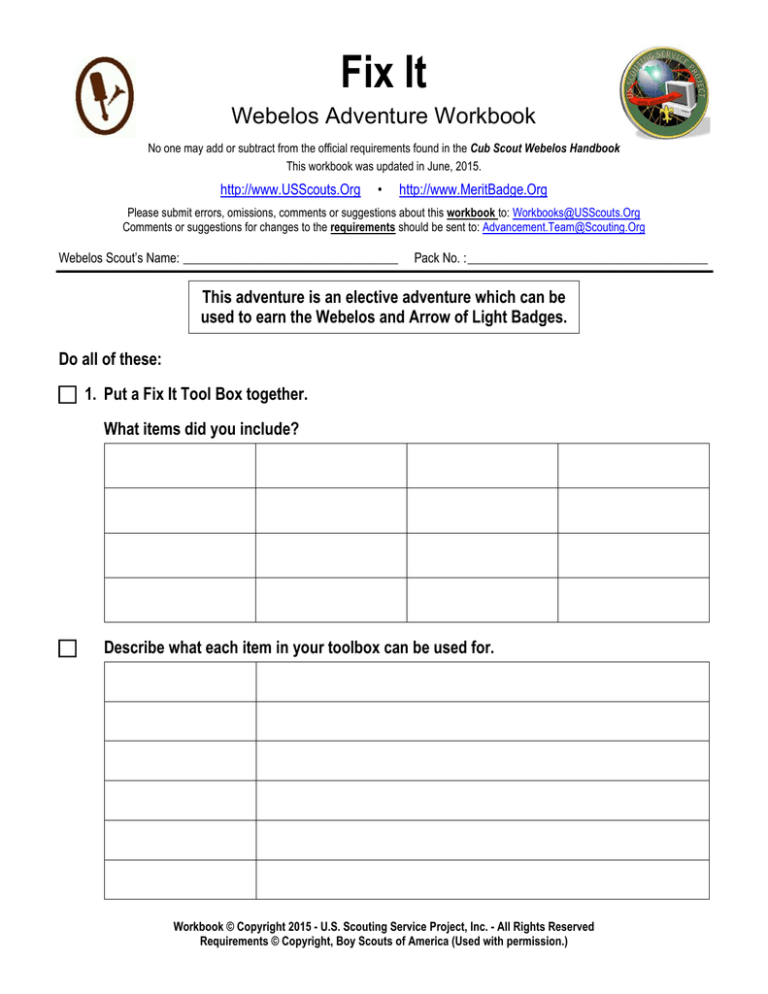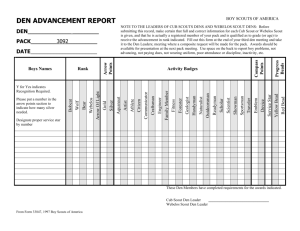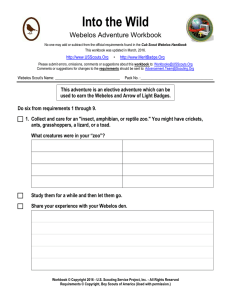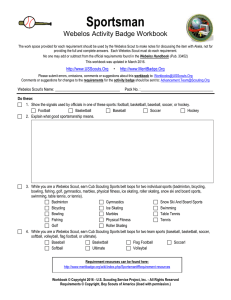
Fix It
Webelos Adventure Workbook
No one may add or subtract from the official requirements found in the Cub Scout Webelos Handbook
This workbook was updated in June, 2015.
http://www.USScouts.Org
•
http://www.MeritBadge.Org
Please submit errors, omissions, comments or suggestions about this workbook to: Workbooks@USScouts.Org
Comments or suggestions for changes to the requirements should be sent to: Advancement.Team@Scouting.Org
Webelos Scout’s Name: __________________________________
Pack No. :______________________________________
This adventure is an elective adventure which can be
used to earn the Webelos and Arrow of Light Badges.
Do all of these:
1. Put a Fix It Tool Box together.
What items did you include?
Describe what each item in your toolbox can be used for.
Workbook © Copyright 2015 - U.S. Scouting Service Project, Inc. - All Rights Reserved
Requirements © Copyright, Boy Scouts of America (Used with permission.)
Fix It
Webelos Scout's Name: ________________________
Show how to use three of the tools safely.
1. _________________________________________________________________________
2. _________________________________________________________________________
3. _________________________________________________________________________
2. Be Ready. With the help of an adult in your family, do the following:
a. Locate the electrical panel in your home. Determine if the electrical panel has
fuses or breakers.
Fuses
Breakers
b. Determine what sort of heat is used to heat your home.
Natural Gas
Propane
Electricity
Fuel Oil
Other: ___________________________________
c. Learn what you would do to shut off the water for a sink, a toilet, a washing
machine, or a water heater.
Fix It Workbook
Page 2 of 6
Fix It
Webelos Scout's Name: ________________________
Sink
Toilet
Washing Machine
Water Heater.
If there is a main shut-off valve for your home, show where it is located.
3. Describe to your Webelos den leader how to fix or make safe the following
circumstances with the help of an adult:
a. A toilet is overflowing.
b. The kitchen sink is clogged.
c. A circuit breaker tripped, causing some of the lights to go out.
Fix It Workbook
Page 3 of 6
Fix It
Webelos Scout's Name: ________________________
4. Let's Fix It. Select and do eight of the following. You will need an adult's supervision for
each of these Fix It projects:
a. Show how to change a light bulb in a lamp or fixture. Determine the type of light
bulb and how to properly dispose of it.
b. Fix a squeaky door or cabinet hinge.
c. Tighten a loose handle or knob on a cabinet or a piece of furniture.
d. Demonstrate how to stop a toilet from running.
e. Replace a furnace filter.
f. Wash a car.
g. Check the oil level and tire pressure in a car.
h. Show how to replace a bulb in a taillight, turn signal, or parking light, or replace a
headlight in a car.
i. Help an adult change a tire on a car.
j. Make a repair to a bicycle, such as adjusting or lubricating the chain, inflating the
tires, fixing a flat, or adjusting the seat or handlebars.
k. Replace the wheels on a skateboard, a scooter, or a pair of inline skates.
l. Help an adult prepare and paint a room.
m. Help an adult replace or repair a wall or floor tile.
n. Help an adult install or repair a window or door lock.
o. Help an adult fix a slow or clogged sink drain.
p. Help an adult install or repair a mailbox.
q. Change the battery in a smoke detector or a carbon monoxide detector, and test
its operation.
r. Help an adult fix a leaky faucet.
s. Find wall studs, and help an adult hang a curtain rod or a picture.
Fix It Workbook
Page 4 of 6
Fix It
Webelos Scout's Name: ________________________
t. Take an old item, such as a small piece of furniture, a broken toy, or a picture
frame, and rebuild and/or refinish it. Show your work to an adult or your Webelos
leader.
u. Do a Fix It project agreed upon with your parent or guardian.
Fix It Workbook
Page 5 of 6
Important excerpts from the Guide To Advancement - 2015, No. 33088 (SKU-620573)
[1.0.0.0] — Introduction
The current edition of the Guide to Advancement is the official source for administering advancement in all Boy Scouts of America
programs: Cub Scouting, Boy Scouting, Varsity Scouting, Venturing, and Sea Scouts. It replaces any previous BSA advancement manuals
and previous editions of the Guide to Advancement.
[Page 4, and 5.0.1.4] — Policy on Unauthorized Changes to Advancement Program
No council, committee, district, unit, or individual has the authority to add to, or subtract from, advancement requirements. There are
limited exceptions relating only to youth members with special needs. For details see section 10, “Advancement for Members With Special
Needs”.
[Page 4] — The “Guide to Safe Scouting” Applies
Policies and procedures outlined in the Guide to Safe Scouting apply to all BSA activities, including those related to advancement and
Eagle Scout service projects.
[4.1.0.3] — Who Approves Cub Scout Advancement?
A key responsibility for den leaders is to implement the den meeting plans as outlined in the four den leader guides shown within this topic.
For Tiger through Bear ranks, if the activity is completed outside of the den meeting, the parent, adult partner, or another trusted adult
should sign in the boy’s handbook, indicating the Cub Scout has done his best to complete the requirement. The den leader then approves
that requirement after consultation with the family or the boy to confirm completion. If the requirement is completed in a den meeting, the
den leader signs in both places. Den leaders may, however, ask an assistant or parent who helps at meetings to play the role of “Akela” and
assist with the approvals. For Webelos and Arrow of Light ranks, the den leader signs for approval of all requirements, unless the den
leader delegates this responsibility.
[4.1.0.4] — “Do Your Best”
Cub Scouts—even those of the same age—may have very different developmental timetables. For this reason, advancement performance in
Cub Scouting is centered on its motto: “Do Your Best.” When a boy has done this—his very best—then regardless of the requirements for
any rank or award, it is enough; accomplishment is noted. This is why den leaders, assistants, and parents or guardians are involved in
approvals. Generally they know if effort put forth is really the Cub Scout’s best.
When a boy completes advancement, he should be congratulated immediately and publicly. And though badges of rank should be reserved
for the next pack meeting, it is best to present items such as belt loops and pins soon after they have been earned. If it is possible for the
pack to report and purchase these awards quickly, they could be presented at a den meeting, rather than waiting for a pack meeting. If
presented at den meetings, the accompanying pocket certificates can be used in a ceremony at a subsequent pack meeting—or vice versa
with the pocket certificates at a den meeting. However this is done, it is important to note that advancement is an individual process, not
dependent on the work or progress of others. Awards should not be withheld for group recognition. Likewise, a boy should not be
presented with recognition he has not earned simply so that he will “not feel left out.”
In the same spirit as “Do Your Best,” if a boy is close to earning a badge of rank when the school year ends, the pack committee, in
consultation with the den leader and the Cub Scout’s parent or guardian, may allow him a few weeks to complete the badge before going on
to the next rank. Earning it will give him added incentive to continue in Scouting and carry on and tackle the next rank.
Additional notes of interest:
Cub Scouts may complete requirements in a family, den, pack, school, or community environment.
“Akela” (Pronounced “Ah-KAY-la”) — Akela (Ah-KAY-la) is a title of respect used in Cub Scouting—any good leader is Akela, who is also
the leader and guide for Cub Scouts on the advancement trail.



